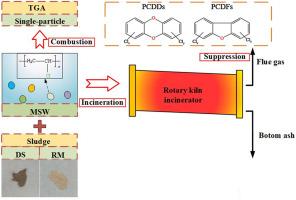Combustion and PCDD/Fs suppression characteristics of waste and sludge blends
IF 6.2
2区 工程技术
Q2 ENERGY & FUELS
引用次数: 0
Abstract
Waste incineration is an efficient method for addressing the increasing global waste production. However, the polychlorinated dibenzo-p-dioxins/dibenzofurans (PCDD/Fs) generated during incineration must be controlled before flue gas emission. Co-combustion of waste with other feedstocks that have high S or alkali metals may suppress the PCDD/Fs formation. This method is cost-effective and convenient. In this study, the co-combustion characteristics of polyvinyl chloride, domestic sludge, and red mud were investigated using the single-particle combustion and thermogravimetric analysis methods. The PCDD/Fs suppression characteristics and mechanisms of municipal solid waste with sludge were investigated using a pilot rotary kiln incinerator. The experimental results indicate that the sludge blending induces synergistic effects during the co-combustion process, and the red mud can suppress the formation of PCDD/Fs, while the domestic sludge promotes the formation of PCDD/Fs. The suppression effect is caused by the basic oxides contents of red mud, while the promotion effect is due to the high Cu content of domestic sludge.

废物和污泥混合物的燃烧和抑制PCDD/Fs特性
垃圾焚烧是解决日益增长的全球垃圾生产的有效方法。然而,焚烧过程中产生的多氯二苯并对二恶英/二苯并呋喃(PCDD/Fs)必须在烟气排放之前进行控制。废物与其他含高硫或碱金属的原料共燃烧可抑制PCDD/Fs的形成。该方法性价比高,使用方便。本研究采用单颗粒燃烧和热重分析的方法,研究了聚氯乙烯、生活污泥和赤泥的共燃特性。采用中试回转窑焚烧装置,研究了含污泥城市生活垃圾对PCDD/Fs的抑制特性及机理。实验结果表明,污泥掺混在共燃过程中产生协同效应,赤泥能抑制PCDD/Fs的形成,而生活污泥则促进PCDD/Fs的形成。抑制作用是由赤泥的碱性氧化物含量引起的,而促进作用是由生活污泥的高铜含量引起的。
本文章由计算机程序翻译,如有差异,请以英文原文为准。
求助全文
约1分钟内获得全文
求助全文
来源期刊

Journal of The Energy Institute
工程技术-能源与燃料
CiteScore
10.60
自引率
5.30%
发文量
166
审稿时长
16 days
期刊介绍:
The Journal of the Energy Institute provides peer reviewed coverage of original high quality research on energy, engineering and technology.The coverage is broad and the main areas of interest include:
Combustion engineering and associated technologies; process heating; power generation; engines and propulsion; emissions and environmental pollution control; clean coal technologies; carbon abatement technologies
Emissions and environmental pollution control; safety and hazards;
Clean coal technologies; carbon abatement technologies, including carbon capture and storage, CCS;
Petroleum engineering and fuel quality, including storage and transport
Alternative energy sources; biomass utilisation and biomass conversion technologies; energy from waste, incineration and recycling
Energy conversion, energy recovery and energy efficiency; space heating, fuel cells, heat pumps and cooling systems
Energy storage
The journal''s coverage reflects changes in energy technology that result from the transition to more efficient energy production and end use together with reduced carbon emission.
 求助内容:
求助内容: 应助结果提醒方式:
应助结果提醒方式:


